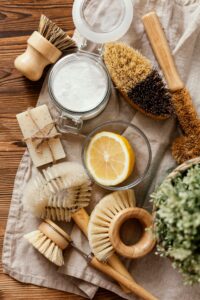
If you recently switched to green cleaning or you simply are not a fan of using chlorine bleach, you may want to know what eco-friendly alternatives to this product are.
Chlorine bleach has a strong, overpowering smell but what is more, the cleaning product has been associated with poor lung health and harmful impacts on the environment. We are glad to inform you that there are, in fact, a number of better ways to disinfect and whiten. Keep reading to find out what some green alternatives to chlorine bleach are. You can use them to disinfect your cutting boards safely or for your laundry.
Here is what you can try:
Hydrogen Peroxide
Hydrogen peroxide is a wonderful green product that can be used as an alternative to chlorine bleach and has many applications around the house. The reason why it is such a good eco-friendly alternative to regular bleach is that it does not contain any harsh chemicals and doesn’t leave a harmful residue on your clothes or items. Instead, it breaks down to water and oxygen.
For all the uses we will mention below, use a 3% hydrogen peroxide solution.
To use hydrogen peroxide instead of bleach in the laundry
Hydrogen peroxide is a great eco-friendly way to keep your whites white. There are a few different ways in which you can use it for your laundry. However,no matter which one you decide to use, always make sure you test hydrogen peroxide on a small, hidden area of your fabrics. One way to use this product is to soak your whites in a bucket of warm water with 200ml of hydrogen peroxide added. Soak for about 15 minutes, then wash how you would normally. You can also add it to your washing machine. Use your regular laundry detergent and as the cycle begins rinsing the clothes, open your laundry detergent drawer and add 200ml of hydrogen peroxide. If you don’t want to do that, dilute 200ml with 400ml water and add this solution to the empty drum of your washing machine. Put your whites inside and run your usual cycle.
To use hydrogen peroxide instead of bleach for disinfection of hard surfaces
Instead of using bleach to disinfect your counters or chopping boards, you can use hydrogen peroxide. It causes oxidation thanks to a highly volatile oxygen atom. During that reaction hydrogen peroxide steals electrons from bacteria, breaking down their cell walls and causing them to die. This product will help you clean your surfaces without leaving a harsh chemical residue. Hydrogen peroxide is effective in killing E-coli, salmonella, and listeria.
When cleaning cutting boards, spray undiluted vinegar onto the board, then wipe it with a clean, damp cloth. Then spray 3% hydrogen peroxide onto the board and wipe it again. Do not ever rush this process since mixing vinegar and hydrogen peroxide will cause a toxic gas to be released. You should also never use this method when cleaning natural stone surfaces like marble, quartz, or granite. Both products are acidic and will permanently damage the stone.
Bicarbonate Soda
Bicarbonate soda (baking soda) is a great way to clean and whiten your whites. It is also cheaper and easier to find than hydrogen peroxide. Baking soda is alkaline, which means it will cut through limescale and laundry detergent residue that cause white clothes to turn gray. That is exactly why it is perfect for keeping whites bright. All you have to do is add a scoopful of bicarbonate soda to your detergent drawer or directly in the drum of your washing machine. That way you will keep your whites white for longer.
Baking soda is also great for tackling grease or mud stains from clothing. Simply, mix baking soda and a bit of water into a paste, add the paste to the stained area, let it dry and wash the garment as usual.
Sodium Percarbonate
Sodium percarbonate also known as oxygen bleach is also a great product that will help you keep your whites bright and remove stains from clothing. When dissolved in water, oxygen bleach releases a mixture of oxygen, water, and soda crystals. That is a great and gentle way to remove stains from both white and coloured fabrics. It also acts as a whitening agent without releasing strong, harmful chemicals.
For best results, use oxygen bleach as a pre-soak. Add 2 tablespoons to 4 liters of warm water and let your clothes soak in this solution for about 6 hours. Then wash as usual.
Lemons
You have probably heard that lemons are good at whitening. Did you know that you can use them for your clothes as well? Citric acid is able to break down stains on white-coloured fabrics and whiten them.
When using lemon juice for your laundry, simply add 200mln of it to your white laundry load. Use it along with your usual detergent. This alternative to chlorine bleach is not the cheapest, but if you find yourself with a large number of lemons, you can try it out.
Solar Power
When it comes to keeping whites white or removing organic stains from white clothing like towels, shirts, or sheets, the power of the sun will help you achieve excellent results. It is one of the best natural, eco-friendly ways in which you can do all that.
To use solar power as an alternative to bleach, simply hang your freshly-washed garments out in the sun. Hang them on a washing line on a sunny day. For best results, make sure their right side is facing the sun, and all stains are exposed to direct sunlight. Let the sun whiten your whites and help fade the stains that can be found on them.